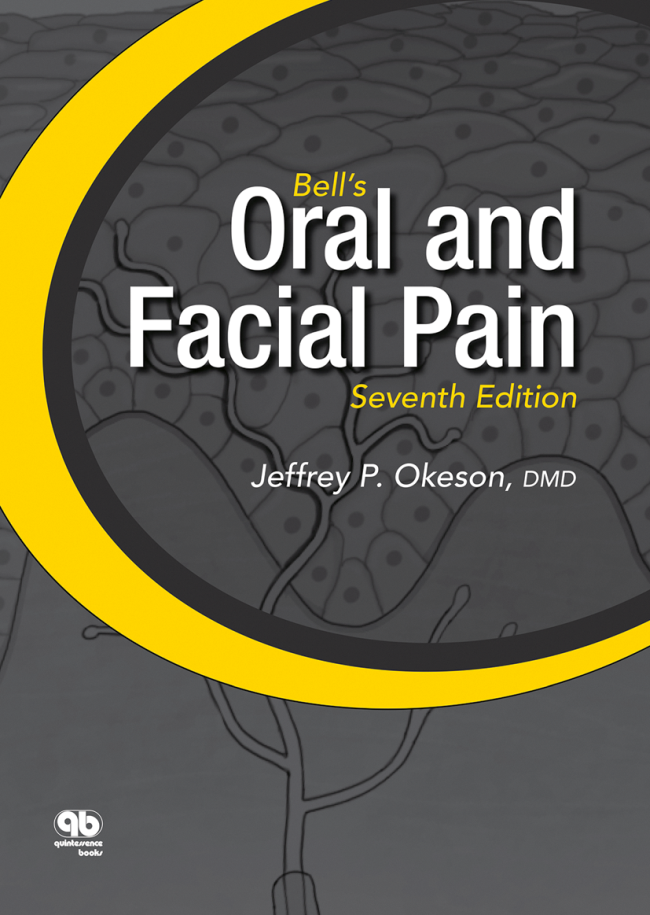Journal of Oral & Facial Pain and Headache, 2/2020
Seiten: 115, Sprache: EnglischOkeson, Jeffrey P.Journal of Oral & Facial Pain and Headache, 2/2019
Seiten: 160-164, Sprache: EnglischMoreno-Hay, Isabel / Mishra, Pratishtha / Okeson, Jeffrey P.Aims: To examine the analgesic effect, safety, and tolerability of intraoral administration of onabotulinum toxin A (BoNT/A) in patients suffering from intractable continuous dentoalveolar neuropathic pain.
Methods: Eight patients (six women and two men) of ages ranging from 21 to 73 years (mean [standard deviation] 52.4 [16.1] years) suffering from continuous dentoalveolar pain for a mean duration of 5.8 (4.4) years received a submucosal injection of 10 to 25 units of BoNT/A into the vestibular mucosa surrounding the painful site. Pain intensity levels were recorded using a verbal rating scale (VRS). Safety and tolerability of BoNT/A were measured based on patient self-report, including any adverse effects reported by the patient at the injection site.
Results: Five of eight patients reported positive pain reduction. In this group, mean pain intensity on a 0-10 VAS was 4.8 (2.2) at baseline and 2.6 (2.1) at postinjection. The analgesic effect was maximal between 7 and 14 days postinjection and lasted for 1 to 8 weeks before subsequently returning to the pre-injection levels. No adverse effects were reported at the injection sites. One patient noted transient partial hemifacial paralysis.
Conclusion: These results suggest the potential therapeutic benefit of BoNT/A in the management of continuous dentoalveolar neuropathic pain. Further investigations conducted via well-controlled studies in the area of orofacial pain are warranted.
Schlagwörter: chronic pain, continuous neuropathic pain, dentoalveolar neuropathic pain, onabotulinum toxin A, orofacial pain
Journal of Craniomandibular Function, 4/2018
Seiten: 324-330, Sprache: Deutsch, EnglischOkeson, Jeffrey P.Kritischer Kommentar 1Die Entwicklung diagnostischer Kriterien dient zwei Hauptzwecken: der wissenschaftlichen Forschung und der klinischen Versorgung. Die ursprünglichen Research Diagnostic Criteria for Temporomandibular Disorders (RDC/TMD)1 lieferten einen ersten Rahmen, der sicherzustellen half, dass Forschungsarbeiten in vergleichbaren, genormten diagnostischen Gruppen durchgeführt wurden. Obwohl diese diagnostischen Kategorien relativ breit definiert waren, sorgten sie für eine gewisse Konsistenz bei der Untersuchung vergleichbarer diagnostischer Populationen. Allerdings boten die ursprünglichen RDC/TMD keine Hilfe bei der Behandlung. Die neueren Diagnostic Criteria for Temporomandibular Disorders (DC/TMD)2 unternehmen den Versuch, die wissenschaftlichen und klinischen Kriterien für die Untersuchung von CMD zu verfeinern. Da CMD-Symptome jedoch bei vielen Kopf- und Nackenbeschwerden häufige Befunde darstellen, sind strenge und vollständige Kriterien schwer zu entwickeln. Den Autoren Steenks, Türp und de Wijer3 ist für die Arbeit an ihrem Schwerpunktartikel zu danken, da sie mehrere Unzulänglichkeiten der neueren DC/TMD aufgezeigt und diskutiert haben. Ihr Schwerpunktartikel bietet eine kritische Bewertung der DC/TMD mit Erläuterungen zu den Vor- und Nachteilen der vorgeschlagenen Leitlinien. Steenks et al. bekunden ihre generelle Unterstützung, äußern aber auch gewisse Bedenken gegenüber den neuen Kriterien. Im Folgenden möchte ich einige ihrer Anmerkungen kommentieren.
Journal of Oral & Facial Pain and Headache, 1/2018
Seiten: 19-21, Sprache: EnglischOkeson, Jeffrey P.Critical Commentary 1Journal of Oral & Facial Pain and Headache, 1/2015
Seiten: 15-23, Sprache: EnglischCustodio, Lilian / Carlson, Charles R. / Upton, Brian / Okeson, Jeffrey P. / Harrison, Anne L. / Leeuw, Reny deAims: To evaluate the impact of cigarette smoking on the sleep quality of patients with masticatory myofascial pain and to determine whether the association between smoking and impaired sleep is influenced by other factors such as demographic, psychological, and behavioral variables.
Methods: Data from a retrospective case series of 529 patients diagnosed with masticatory myofascial pain according to group I of the Research Diagnostic Criteria for Temporomandibular Disorders were obtained. Patients completed a standardized pain questionnaire and psychometric tests. Differences between smokers and nonsmokers were evaluated using independent samples t tests and chi-square tests. Hierarchical linear multiple regression models were used to examine predictors of sleep disturbances.
Results: Of the entire sample, 170 (32%) reported that they were smokers. Smokers reported higher pain severity and more sleep disturbances and psychological distress than nonsmokers. Cigarette smoking significantly predicted sleep disturbance (β = 0.229, P .001), but this relationship was attenuated after controlling for pain severity and psychological distress (β = 0.122, P .001).
Conclusion: Cigarette smoking is associated with numerous adverse health outcomes, including pain severity, alterations in mood, and disrupted sleep, and seems to be a significant predictor of sleep quality in patients with masticatory myofascial pain.
Schlagwörter: masticatory myofascial pain, psychological distress, sleep quality, smoking, temporomandibular disorders
Journal of Oral & Facial Pain and Headache, 2/2011
Seiten: 117-124, Sprache: EnglischPorto, Felipe / De Leeuw, Reny / Evans, Daniel R. / Carlson, Charles R. / Yepes, Juan F. / Branscum, Adam / Okeson, Jeffrey P.Aim: To examine differences between idiopathic continuous orofacial neuropathic pain (ICONP) patients and chronic masticatory muscle pain (MMP) patients for psychosocial functioning and sleep quality.
Methods: Archival data were used to compare 81 ICONP patients to 81 age- and sex-matched chronic MMP patients on pain severity, life interference, life control, and affective distress measures from the Multidimensional Pain Inventory (MPI), a global severity index of psychological symptoms from the Symptom Checklist-90-R (SCL-90-R), Posttraumatic Stress Disorder Checklist-Civilian (PCL-C), and overall sleep quality from the Pittsburgh Sleep Quality Index (PSQI). MANOVA, MANCOVA, and chi-square analysis were used to investigate differences between the two groups in the psychosocial and sleep variables.
Results: The ICONP group reported greater pain severity (P = .013) and more life interference (P = .032) than the MMP group, while the MMP group reported higher levels of global psychological symptoms (P = .005) than the ICONP group. After controlling for pain severity, however, the MMP group demonstrated greater affective distress (P = .014) than the ICONP group, and life interference was no longer significantly different between the groups. ICONP patients were more likely to report a traumatic life event (P = .007).
Conclusion: Although ICONP patients are likely to present more intense pain and report that their pain causes more interference in their lives, MMP patients are more likely to present with higher levels of overall psychological symptoms. The greater levels of pain severity reported by ICONP patients appear to be partially responsible for their higher levels of reported life interference.
Schlagwörter: masticatory muscle pain, neuropathic pain, orofacial pain, psychosocial, sleep quality Full Text PDF File | Order Article
Journal of Oral & Facial Pain and Headache, 1/2010
Seiten: 89-100, Sprache: EnglischDavis, C. Ervin / Carlson, Charles R. / Studts, Jamie L. / Curran, Shelly L. / Hoyle, Rick H. / Sherman, Jeffrey J. / Okeson, Jeffrey P.Aims: To develop and test a biopsychosocial model using structural equation modeling for predicting orofacial pain symptoms in a sample of patients with masticatory muscle pain (MMP).
Methods: Data were collected from clinic records of 251 adult patients who presented for initial evaluation to the Orofacial Pain Center at the University of Kentucky College of Dentistry and were subsequently diagnosed with MMP. Data were used to fit a model relating stressors, psychological distress, arousal, sleep problems, oral parafunction, and pain symptoms. Items from the Multidimensional Pain Inventory (MPI) and the IMPATH:TMJ, a comprehensive biopsychosocial assessment of patients with temporomandibular disorders (TMD), were used to construct a measurement model of five latent variables.
Results: Estimation of the model indicated a good fit to the data and significant associations between stressors, psychological distress, arousal, sleep problems, and pain symptoms. Sleep problems partially mediated the relation between arousal and pain symptoms. Contrary to hypotheses, no association occurred between oral parafunction and pain symptoms, possibly indicating that any relationship between oral parafunction and pain symptoms may not exist.
Conclusion: Results from the model tested in the present study are an additional step toward developing a more comprehensive biopsychosocial model explaining the nature and etiology of MMP in orofacial pain and TMD. With additional development and testing, it may also serve as an aid to planning interventions, especially psychosocial interventions targeting stress management, psychophysiological regulation, psychological distress, and sleep problems.
Schlagwörter: biopsychosocial factors, chronic orofacial pain, masticatory muscle pain, structural equation model, temporomandibular disorders
Journal of Oral & Facial Pain and Headache, 4/2009
Seiten: 312-315, Sprache: EnglischOkeson, Jeffrey P.Journal of Oral & Facial Pain and Headache, 2/2007
Seiten: 107-119, Sprache: EnglischBertoli, Elizangela / de Leeuw, Reny / Schmidt, John E. / Okeson, Jeffrey P. / Carlson, Charles R.Aim: To evaluate temporomandibular disorder (TMD) patients for differences between masticatory muscle (MM) and temporomandibular joint (TMJ) pain patients in the prevalence of post-traumatic stress disorder (PTSD) symptoms and evaluate the level of psychological dysfunction and its relationship to PTSD symptoms in these patients.
Methods: This study included 445 patients. Psychological questionnaires included the Symptom Check List-90-Revised (SCL-90-R), the Multidimensional Pain Inventory, the Pittsburgh Sleep Quality Index, and the PTSD Check List Civilian. The total sample of patients was divided into 2 major groups: the MM group (n = 242) and the TMJ group (n = 203). Each group was divided into 3 subgroups based on the presence of a stressor and severity of PTSD symptoms.
Results: Thirty-six patients (14.9%) in the MM group and 20 patients (9.9%) in the TMJ group presented with PTSD symptomatology (P = .112). Significant differences were found between the MM and the TMJ group in several psychometric domains, but when the presence of PTSD symptomatology was considered, significant differences were mostly maintained in the subgroups without PTSD. MM and TMJ pain patients in the "positive PTSD" subgroups scored higher on all SCL-90-R scales (P .001) than patients in the other 2 subgroups and reached levels of distress indicative of psychological dysfunction. TMJ pain patients (58.3%; P = .008) in the positive-PTSD subgroups were more often classified as dysfunctional. Both positive-PTSD subgrounps of the MM and TMJ groups presented with more sleep disturbance (P .005) than patients in the other 2 subgroups.
Conclusion: A somewhat elevated prevalence rate for PTSD symptomatology was found in the MM group compared to the TMJ group. Significant levels of psychological dysfunction appeared to be linked to TMD patients with PTSD symptoms.
Schlagwörter: prevalence, post-traumatic stress disorder, psychological dysfunction, sleep disturbances, temporomandibular disorders
The International Journal of Oral & Maxillofacial Implants, 1/2006
PubMed-ID: 16519193Seiten: 136-140, Sprache: EnglischQueral-Godoy, Elena / Vazquez-Delgado, Eduardo / Okeson, Jeffrey P. / Gay-Escoda, CosmeThe present case report depicts the management of a patient with persistent idiopathic facial pain following the placement of 2 dental implants in the mandibular anterior alveolar ridge. After 15 months of unsuccessful diagnosis and management, the patient was seen at the Orofacial Pain Unit of the Oral Surgery and Implantology master's degree program of the University of Barcelona. Seven months after treatment onset, a combination of nortriptyline, clonazepam, and relaxation procedures has successfully controlled the patient's facial pain symptoms.
Schlagwörter: atypical facial pain, dental implants, idiopathic facial pain




